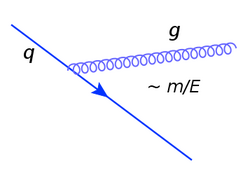Physics:Dead-cone effect
In particle physics, the dead-cone effect is a phenomenon [1][2] that leads to a suppression of radiation from a charged particle of mass [math]\displaystyle{ m }[/math] and energy [math]\displaystyle{ E }[/math] within an angular size of [math]\displaystyle{ m/E }[/math]. For example, a parton created by a heavy quark is suppressed within a cone around the direction of the quark’s motion and that the angular size of the cone is proportional to the quark mass. As the result, the existence of this dead cone changes the angular distribution of the resulting hadronic jets. This effect is universal as it does not depend on the spin of the particle nor on the nature of the gauge interaction.
The dead-cone effect is predicted in quantum chromodynamics— the theory of strong interactions — but has never been observed directly. A direct observation of the dead-cone effect in QCD is challenging since its observation requires the reconstruction of the cascading quarks and gluons from the experimentally accessible hadrons. However, the hadronisation effect can distort angular features of partons.
Practical methods to detect the dead-cone angular suppression have been discussed since the HERA experiments in 2000x [3]. In 2022, the dead cone was found by the ALICE collaboration at CERN[4].
References
- ↑ Yu. L. Dokshitzer, V. A. Khoze, S. I. Troyan, in Proc. 6th Int. Conf. on Physics in Collision, ed. M. Derrick (World Scientific, Singapore, 1987), p.417.
- ↑ Yu. L. Dokshitzer, V. A. Khoze, S. I. Troyan, J.Phys. G17, 1481, 1602, (1991).
- ↑ S.V.Chekanov, Soft-Gluon Angular Screening in Heavy-Quark Fragmentation, arXiv:hep-ph/0005119, Phys.Lett.B484:51-57,2000
- ↑ ALICE Collaboration, Direct observation of the dead-cone effect in QCD, CERN-EP-2021-107, Nature 605 (2022) 440-446, https://arxiv.org/abs/2106.05713


